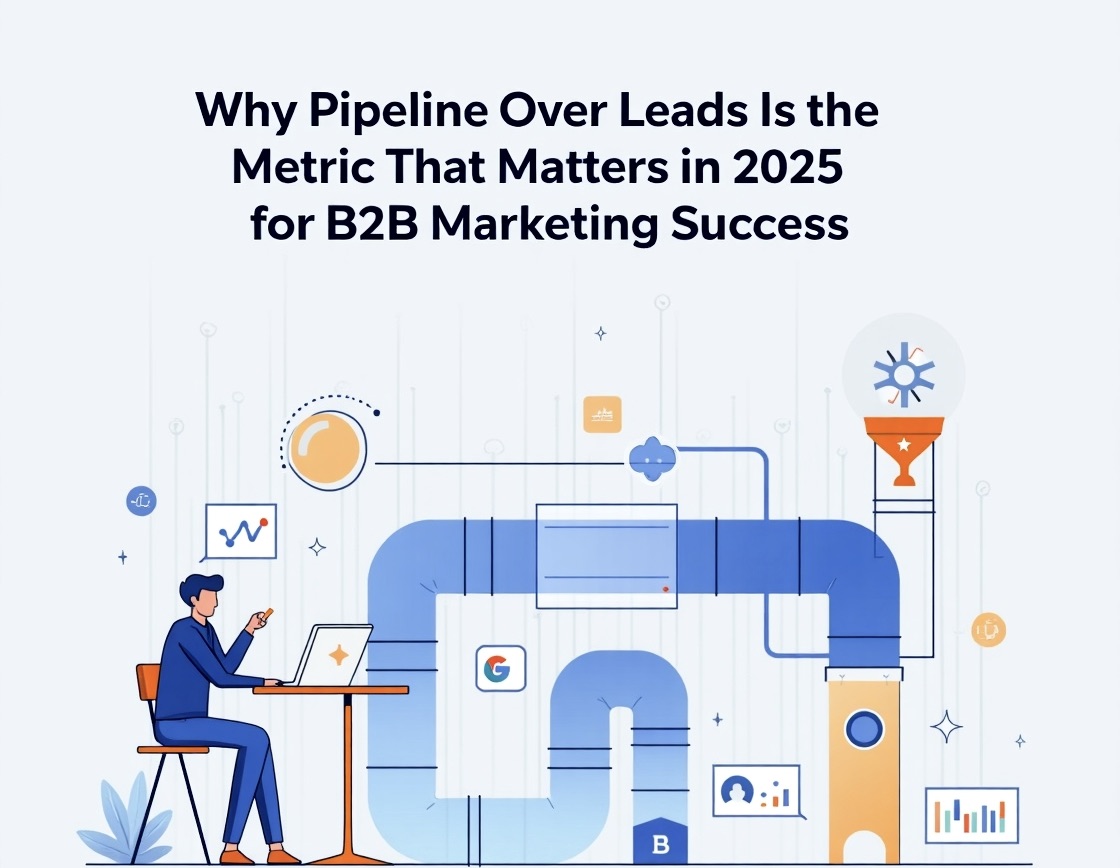
Why Pipeline Over Leads Is the Metric That Matters Most in 2025 for B2B Marketing Success
B2B marketing in 2025 is no longer just about generating leads—it’s about generating the right leads. More specifically, it’s about building a strong, high-intent sales pipeline. In an increasingly data-driven and revenue-focused environment, the age-old metric of “lead volume” has taken a back seat to a more strategic KPI: pipeline over leads contribution.
For B2B Marketing Directors, this shift represents both a challenge and an opportunity. On one hand, there’s growing pressure to align with sales teams and prove marketing’s direct impact on revenue. On the other, there’s a chance to lead meaningful change by refining how success is measured, focusing on opportunities with real buying intent rather than vanity metrics like form fills.
This article explores why pipeline over leads has become the primary marketing metric in 2025, the problems that arise from misalignment between sales and marketing, and how to recalibrate your strategy for long-term, revenue-driven success.
The Problem with Chasing Leads in 2025
Let’s face it: not all leads are created equal.
Many B2B marketing teams still measure success by the sheer number of leads generated. But when those leads don’t convert—or worse, aren’t even qualified—marketing’s efforts can feel disconnected from actual business outcomes. Sales teams become frustrated, resources get wasted, and finger-pointing ensues.
This misalignment is often rooted in:
- Overreliance on top-of-funnel metrics like downloads, form completions, or event signups
- Lack of a shared definition of a qualified lead
- Minimal collaboration between marketing and sales during campaign planning
- KPIs that reward volume over value
In 2025, high-growth companies are flipping the script. They’re asking: Is this lead likely to buy? If the answer is no, it doesn’t belong in your pipeline—no matter how many MQL points it racks up.
Pipeline Over Leads: The Revenue Metric That Unites Teams
When you shift focus from leads to pipeline, you start measuring what truly matters: potential revenue.
Pipeline contribution refers to the portion of the sales pipeline that originated from marketing efforts. It shows how much pipeline marketing is generating, not just how many people clicked on an ad or downloaded an eBook.
Here’s why this matters:
- It creates alignment. Sales and marketing work together toward a shared goal: revenue growth.
- It focuses efforts on buyers with intent. You prioritize actions that bring in sales-ready opportunities.
- It increases accountability. Marketing must understand sales cycles, personas, and buyer journeys.
- It improves efficiency. You waste less time and money on campaigns that attract unqualified leads.
According to a 2025 Gartner report, B2B companies that align marketing KPIs with pipeline contribution see a 30% increase in conversion rates and a 25% decrease in acquisition costs.
Signs You’re Still Lead-Centric—and How to Fix It With Pipeline Over Leads
Are you still stuck in a lead-driven mindset? Look for these red flags:
- Your primary marketing goal is to “generate X number of MQLs”
- Sales often rejects or ignores your leads
- You celebrate traffic spikes without understanding their downstream impact
- Campaigns are launched without input from sales
But How to transition to a pipeline-first mindset:
- Redefine success metrics. Start tracking marketing-sourced pipeline and SQL conversions.
- Collaborate early with sales. Co-create ICPs (Ideal Customer Profiles) and define what a high-quality opportunity looks like.
- Implement lead scoring based on buying behavior, not just engagement.
- Prioritize intent signals—such as pricing page views, product demo requests, or late-stage content interactions.
- Invest in attribution tools to measure the actual impact of marketing on pipeline growth.
Building a Pipeline over leads-Driven Marketing Strategy
Making the shift requires more than just changing your KPIs—it demands a fundamental transformation of your marketing approach. Here’s how to do it:
Align Marketing and Sales Around Shared Goals
Start with regular meetings between your marketing and sales leaders. Discuss campaign ideas, define qualification criteria, and review pipeline metrics together.
Create a service-level agreement (SLA) that outlines:
- What marketing promises to deliver (e.g., number of SQLs per quarter)
- What sales commits to follow up on
- How feedback will be shared and implemented
Focus on Revenue-Generating Channels
Not all channels drive pipeline equally. In 2025, leading B2B marketers are doubling down on:
- Account-Based Marketing (ABM): Targeting high-fit accounts with personalized outreach
- Intent data platforms: Identifying prospects actively researching solutions in your category
- Product-led content: Offering demos, ROI calculators, and success stories that attract bottom-funnel interest
Use Full-Funnel Content to Nurture High-Intent Leads
Rather than flooding the top of the funnel, focus on content that moves decision-makers through the buyer’s journey. Examples include:
- Case studies and use cases
- Comparison guides
- Webinars with sales participation
- Customer interviews or ROI showcases
This approach not only nurtures genuine interest but also qualifies leads faster.
Measuring How Pipelines Over Leads Matters in 2025
Marketing’s value is no longer proven by volume—it’s demonstrated through impact.
Here are the metrics modern B2B marketers are using to track performance:
- Pipeline Over Leads Contribution: Total value of opportunities sourced by marketing
- Conversion Rate to Opportunity: MQL to SQL to closed-won
- Sales Cycle Velocity: How fast leads progress once marketing hands them off
- Win Rate of Marketing-Sourced Deals: Indicator of lead quality
- Revenue Influenced: Total revenue touched by marketing interactions
You can still track form fills and content downloads—but only as directional signals, not end goals.
Conclusion: Shift from Counting Leads to Creating Revenue
In 2025, the most successful B2B marketing directors are those who embrace the shift from lead generation to pipeline generation. By aligning more closely with sales, focusing on high-intent opportunities, and measuring impact based on revenue contribution, you build not just a better funnel—but a stronger business.
If you’re ready to make this shift, start by redefining your success metrics and opening up new lines of collaboration with sales. The more tightly your teams align around shared revenue goals, the more impactful your marketing efforts will become.


